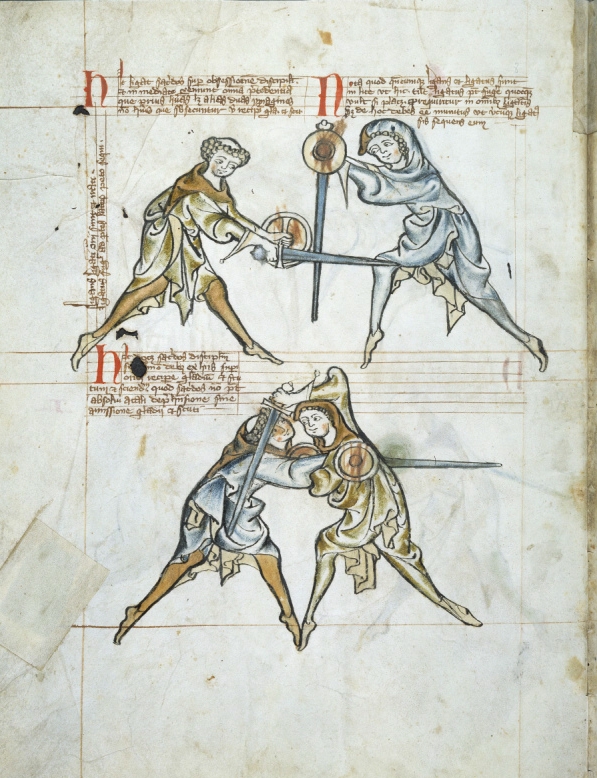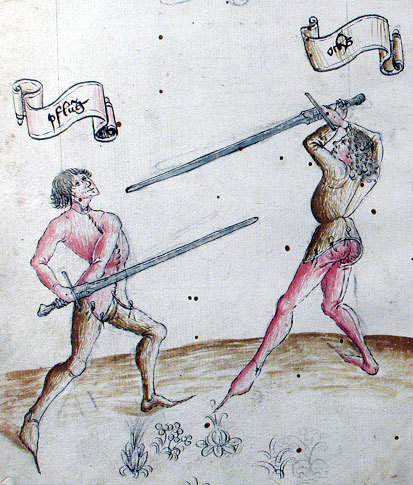|
MS I.33
Royal Armouries Ms. I.33 is the earliest known surviving European ''fechtbuch'' (combat manual), and one of the oldest surviving martial arts manuals dealing with armed combat worldwide. I.33 is also known as the Walpurgis manuscript, after a figure named Walpurgis shown in the last sequence of the manuscript, and "the Tower manuscript" because it was kept in the Tower of London during 1950-1996; also referred to as British Museum No. 14 E iii, No. 20, D. vi. It was created around 1300 in Franconia and is first mentioned by Henricus a Gunterrodt in his ''De veriis principiis artis dimicatoriae'' of 1579. The manuscript is anonymous and is so titled through an association with the Royal Armouries Museum. The manuscript The manuscript including the text date to about 1270-1320 CE It is first mentioned by Henricus a Gunterrodt in his ''De veriis principiis artis dimicatoriae'' of 1579, where he reports it to have been acquired (looted) by a friend of his, one Johannes Herbart of W├ ... [...More Info...] [...Related Items...] OR: [Wikipedia] [Google] [Baidu] |
MS I33 32r
MS, ms, Ms, M.S., etc. may refer to: Arts and entertainment * ''Ms.'' (magazine), an American feminist magazine * Metal Storm (webzine), a heavy metal website based in Estonia Businesses and organizations * MS-13, criminal gang * Missionaries of La Salette, a Catholic male religious order * M┼éodzi Socjali┼Ťci (Young Socialists), a former Polish socialist youth organization * Morgan Stanley, a US investment bank (NYSE stock symbol: MS) * Mj├│lkursamsalan, an Icelandic dairy company Educational qualifications * Master of Science, a master's degree in the field of science * Master of Surgery, an advanced medical degree * Master Sommelier, a terminal degree in the field of wine * '' Mast├Ęre sp├ęcialis├ę'', a French postgraduate ''grande ├ęcole'' master's degree Medicine * Mitral stenosis, narrowing of the mitral valve of the heart * Morphine sulfate, an opiate pain-relieving drug * Multiple sclerosis, a disease of the nervous system Military * Master seaman, a non-commissi ... [...More Info...] [...Related Items...] OR: [Wikipedia] [Google] [Baidu] |
Royal Armouries
The Royal Armouries is the United Kingdom's national collection of arms and armour. Originally an important part of England's military organization, it became the United Kingdom's oldest museum, originally housed in the Tower of London from the 15th century, and one of the oldest museums in the world. It is also one of the oldest and largest collections of arms and armour in the world, comprising the UK's National Collection of Arms and Armour, National Artillery Collection, and National Firearms Collection. Its historic base is in the Tower of London, but today the collection is split across three sites: the Tower, the Royal Armouries Museum in Leeds, and Fort Nelson near Portsmouth From 2004 to 2015, a limited selection of items was also on display in Louisville, Kentucky, in the United States, in cooperation with the Frazier History Museum. History The Royal Armouries is one of the ancient institutions of the Tower of London and was originally engaged in the manufacture ... [...More Info...] [...Related Items...] OR: [Wikipedia] [Google] [Baidu] |
Combat Treatises
Combat (French for ''fight'') is a purposeful violent conflict meant to physically harm or kill the opposition. Combat may be armed (using weapons) or unarmed ( not using weapons). Combat is sometimes resorted to as a method of self-defense, or can be used as a tool to impose one's will on others. An instance of combat can be a stand-alone confrontation or a small part of a much larger violent conflict. Instances of combat may also be benign and recreational, as in the cases of combat sports and mock combat. Combat may comply with, or be in violation of local or international laws regarding conflict. Examples of rules include the Geneva Conventions (covering the treatment of people in war), medieval chivalry, the Marquess of Queensberry rules (covering boxing) and several forms of combat sports. Hand-to-hand combat Hand-to-hand combat (melee) is combat at very close range, attacking the opponent with the body ( striking, kicking, strangling, etc.) and/or with a melee weapo ... [...More Info...] [...Related Items...] OR: [Wikipedia] [Google] [Baidu] |
14th-century Illuminated Manuscripts
As a means of recording the passage of time, the 14th century was a century lasting from 1 January 1301 ( MCCCI), to 31 December 1400 ( MCD). It is estimated that the century witnessed the death of more than 45 million lives from political and natural disasters in both Europe and the Mongol Empire. West Africa experienced economic growth and prosperity. In Europe, the Black Death claimed 25 million lives wiping out one third of the European population while the Kingdom of England and the Kingdom of France fought in the protracted Hundred Years' War after the death of Charles IV, King of France led to a claim to the French throne by Edward III, King of England. This period is considered the height of chivalry and marks the beginning of strong separate identities for both England and France as well as the foundation of the Italian Renaissance and Ottoman Empire. In Asia, Tamerlane (Timur), established the Timurid Empire, history's third largest empire to have been ever esta ... [...More Info...] [...Related Items...] OR: [Wikipedia] [Google] [Baidu] |
Association For Renaissance Martial Arts
Association for Renaissance Martial Arts (ARMA) is a US-based non-profit organization dedicated to the study and practice of historical European martial arts of the 15th to 17th centuries.About This article contains information about the goals and aims of the Association for Renaissance Martial Arts. ARMA was formed in 2001 under director John Clements as a continuation of the Historical Armed Combat Association (HACA, since 1992). As of 2006, the ARMA claimed a number of close to 500 paying members. They also list a number of "Academic Consultants". History The ARMA began in 1992 as the Historical Armed Combat Association (HACA), a group led principally by Hank Reinhardt, an avid sword enthusiast. Reinhardt's idea was to ...[...More Info...] [...Related Items...] OR: [Wikipedia] [Google] [Baidu] |
Brian R
Brian (sometimes spelled Bryan in English) is a male given name of Irish and Breton origin, as well as a surname of Occitan origin. It is common in the English-speaking world. It is possible that the name is derived from an Old Celtic word meaning "high" or "noble". For example, the element ''bre'' means "hill"; which could be transferred to mean "eminence" or "exalted one". The name is quite popular in Ireland, on account of Brian Boru, a 10th-century High King of Ireland. The name was also quite popular in East Anglia during the Middle Ages. This is because the name was introduced to England by Bretons following the Norman Conquest. Bretons also settled in Ireland along with the Normans in the 12th century, and 'their' name was mingled with the 'Irish' version. Also, in the north-west of England, the 'Irish' name was introduced by Scandinavian settlers from Ireland. Within the Gaelic speaking areas of Scotland, the name was at first only used by professional families of I ... [...More Info...] [...Related Items...] OR: [Wikipedia] [Google] [Baidu] |
Fool's Guard
The German school of fencing (') is a system of combat taught in the Holy Roman Empire during the Late Medieval, German Renaissance, and Early Modern periods. It is described in the contemporary Fechtb├╝cher ("fencing books") written at the time. The geographical center of this tradition was in what is now Southern Germany including Augsburg, Frankfurt, and Nuremberg. During the period in which it was taught, it was known as the ', or the ''"Art of Fighting"''. The German school of fencing focuses primarily on the use of the two-handed longsword; it also describes the use of many other weapons, including polearms, medieval daggers, messers (with or without a buckler), and the staff, as well as describing mounted combat and unarmed grappling (''ringen''). Most authors of writings on the system are, or claim to be, in the tradition of the 14th-century master Johannes Liechtenauer. The earliest surviving treatise on Liechtenauer's system is a manuscript dated to 1389, known ... [...More Info...] [...Related Items...] OR: [Wikipedia] [Google] [Baidu] |
Langort
Langort is a position in the German School of historical fencing. In the Langort position, the point of the sword is extended. The term appears first in Royal Armouries Ms. I.33. In modern literature, sometimes it is identified with the position ''vom tage'' in the system of Johannes Liechtenauer, according to Ms. N├╝rnberger Handschrift GNM 3227a Codex 3227a of the in Nuremberg (also known as ''Hs. 3227a'', ''GNM 3227a'', ) is a manuscript of 169 folia, dated to the close of the 14th century. Its text is written in Latin and German. The German portions have been identified as in East .... Although ''vom tage'' is executed with both hands and sword high over the head, while "Langort" is executed with both hands pointing away from the body, directly at the contrahent. Also, ''vom tage'' is a very active position that gives you the opportunity to start a variety of attacks, while "Langort" is highly defensive and passive, mostly used to force a contrahent with shorter blad ... [...More Info...] [...Related Items...] OR: [Wikipedia] [Google] [Baidu] |

.jpg)


